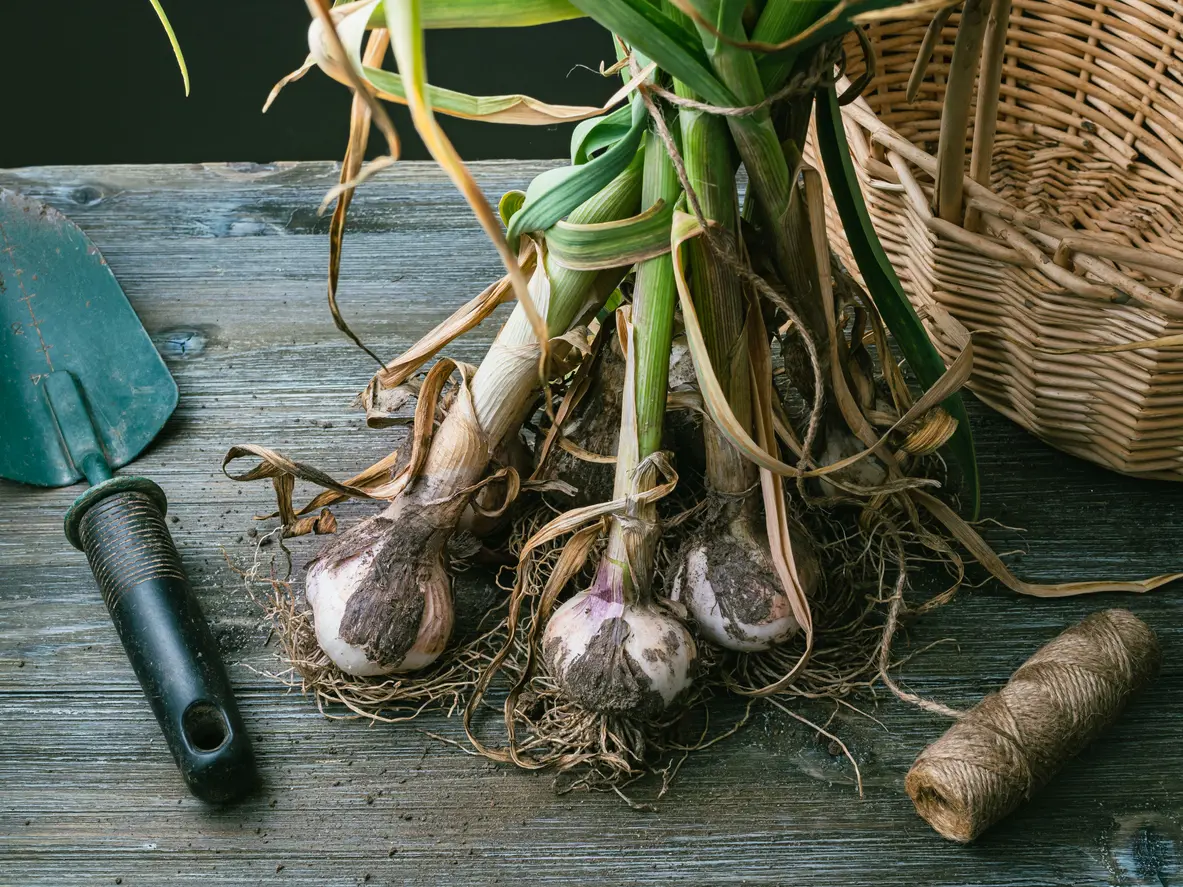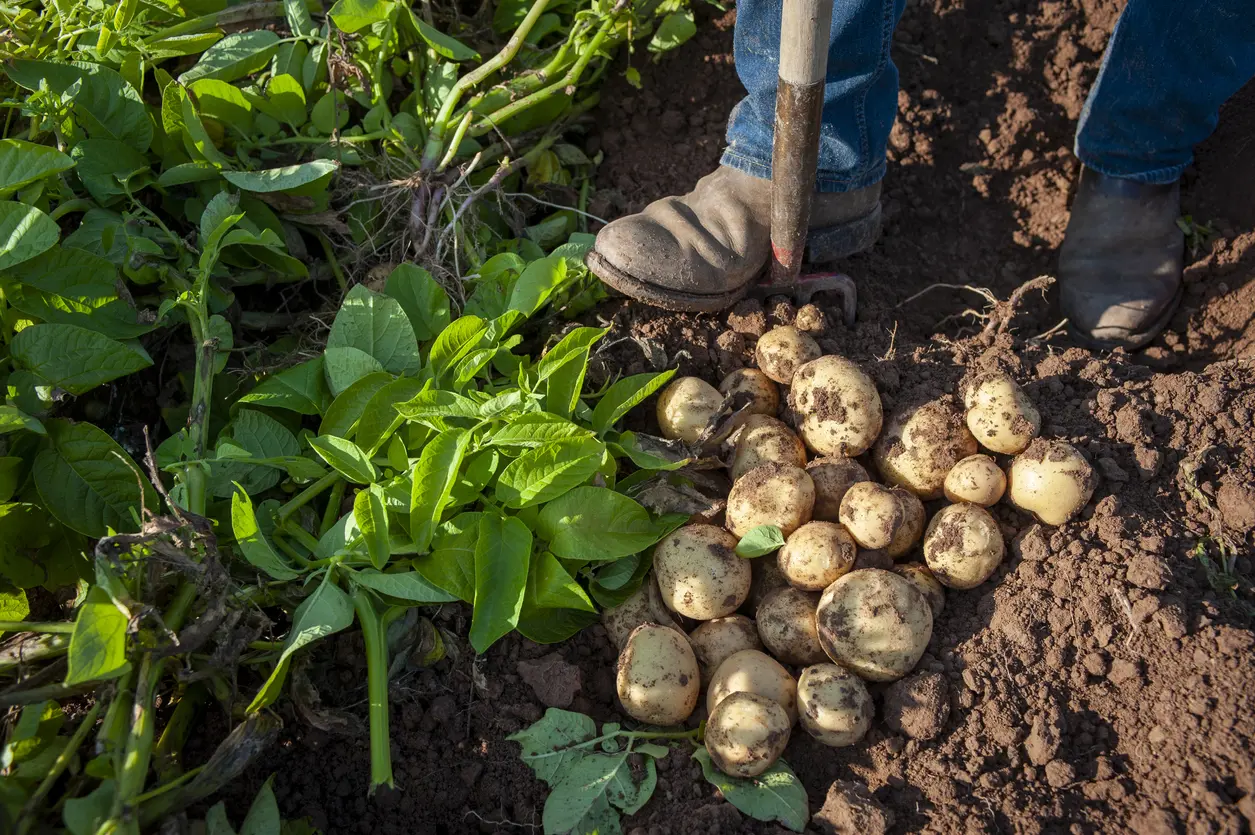
Potatoes are one of the most popular crops on the planet, and you don't need a farm to grow them. With the right conditions, potatoes can easily thrive in a variety of climates, making them an excellent choice for gardeners of all experience levels.
Whether you have your own home garden or just a few containers on your patio, you can grow a hearty crop of potatoes with just a little time and effort.
In this guide, you'll learn everything you need to get started, from choosing the right seed potatoes to preparing your soil. With the proper tools and techniques, you'll be growing and harvesting in no time.
The Best Potatoes for Home Gardens
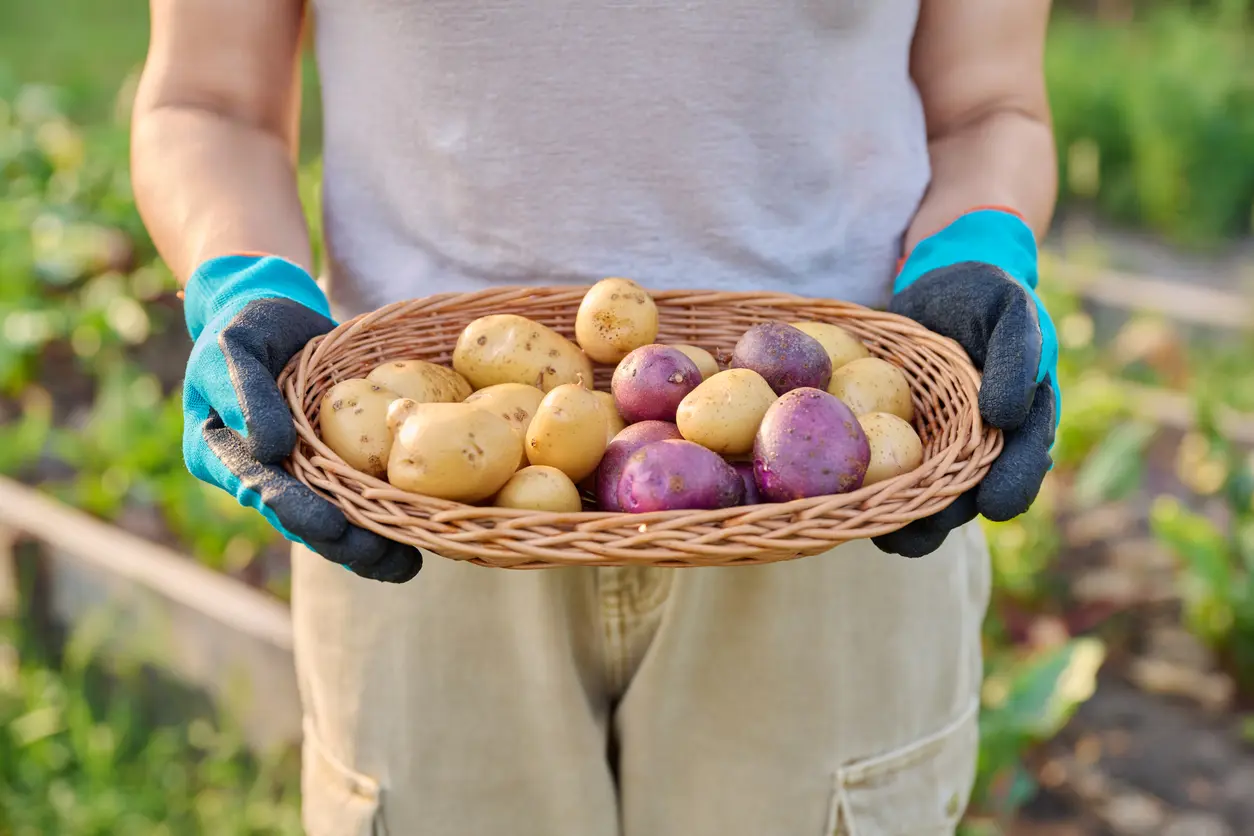
With so many varieties available, selecting the best potato for your home garden can seem overwhelming. It's important to consider the following key factors:
- Your growing season,
- The length of time you plan to store your potatoes, and
- How you intend to use them.
You may prefer a certain color of potato for a fun serving presentation or a particular average size. There are plenty of resources out there to help you decide. If you know any other local growers with more experience, ask them what varieties they love. Each state has a system of cooperative extension offices that can offer support for your home garden activities as well. Your local branch will likely have suggestions to help you select the right variety.
Some popular varieties in American home gardens include Yukon Gold, [1] Katrina A. Zavislan, Dr. David G. Holm, and Robin Young Potatoes in the Home Garden – 7.617 Russet, [2] Marissa Schuh, Extension educator, and Cindy Tong, Extension specialist Growing potatoes in home gardens and Dark Red Norland. [3] Varietal Selection
Ideal Potato Growing Conditions
You may have questions about the ideal conditions for potatoes in your garden. The best soil for potatoes will vary slightly depending on whether you are growing early-season or mid- to late-season potatoes. For early varieties, sandy to loamy soil with a pH between 6.5 and 7.5 is perfect. For later-season potatoes, you will want slightly heavier soil.
Regardless, the garden soil should be well-drained with appropriate fertility. To check your soil’s fertility, soil testing is the best approach. Most state universities offer soil testing services and can guide you on how to do one in your garden.
Potato plants thrive in full sun, requiring direct light for at least 6 hours each day, although 8 to 10 hours of daily sunlight is even better. [4] University of Maryland Extension Growing Potatoes in a Home Garden Make sure the area you choose to plant meets this requirement.
When to Plant Potatoes: What’s Your Zone?
The best time to plant potatoes depends on your location. Generally, planting will fall between mid-March and early summer. Potatoes will withstand light frost, but soil temperatures should consistently be above 45 degrees Fahrenheit for planting. [4] University of Maryland Extension Growing Potatoes in a Home Garden
If you’re unsure about the timing for your area, check with your local gardening club or cooperative extension office. Another resource is the USDA Plant Hardiness Zone Map, which allows you to enter your zip code and identify your local planting climate zone. [5] You can then use it to determine the best time to plant.
How to Plant Potatoes: Your Step-By-Step Guide
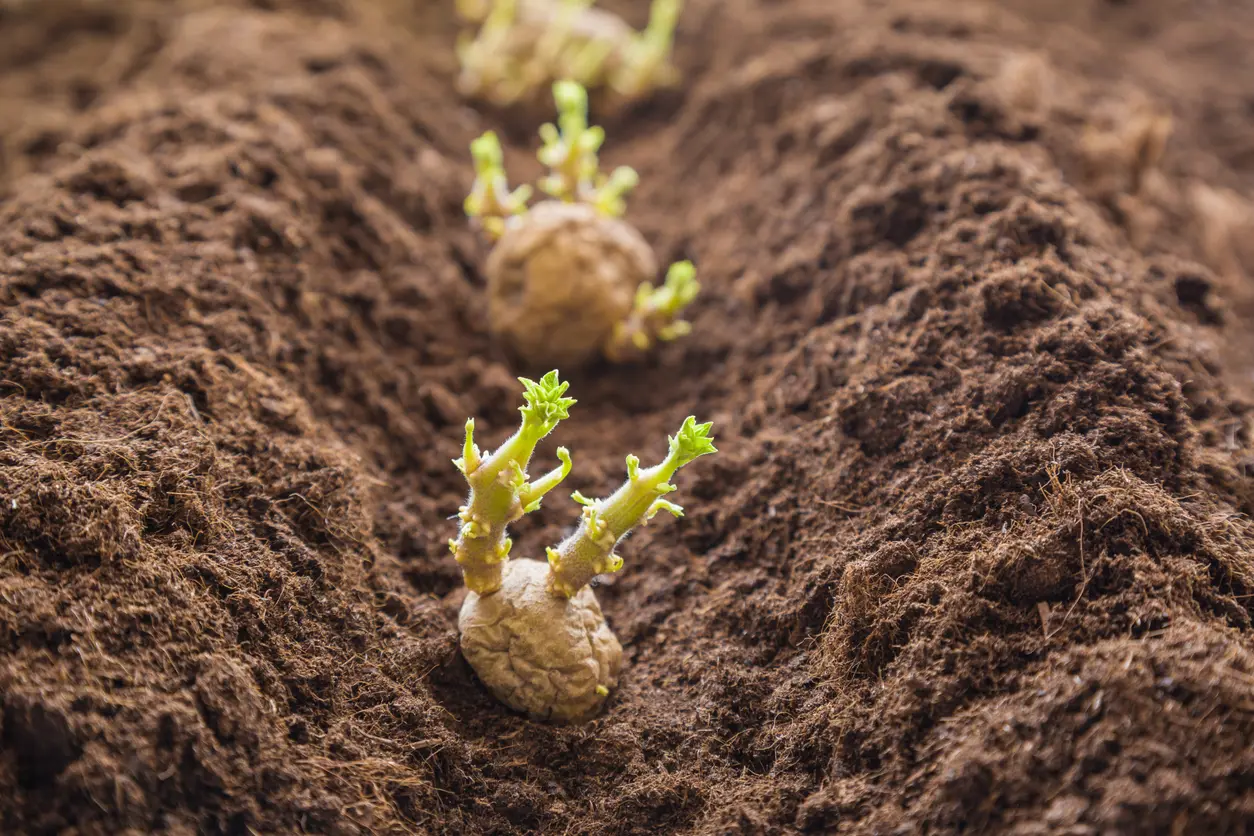
Potatoes grow from existing tubers. The new plant will originate from the “eyes” of the parent potato. Most garden seed purveyors will sell seed potatoes in your choice of variety, but make sure these starters are certified as disease-free. Seed potatoes should be firm, without sprouts. To begin planting:
- Use a clean, sharp knife to cut the seed potatoes into approximately 1½-inch cubes, with 1 to 3 eyes per piece. [4] University of Maryland Extension Growing Potatoes in a Home Garden
- Allow the pieces to dry for a few days before planting to minimize the risk of fungal disease.
- Make rows in your garden spot. Your rows should be 2 to 4 inches deep and 2 to 3 feet apart. [6] Planting and Spacing
- Place seed pieces 8 to 20 inches apart, cut side down. If you plan to harvest smaller “new potatoes,” put the seeds closer to the 8-inch recommendation. For a more mature harvest, space them farther apart.
- Cover the potato seeds with 2 to 4 inches of soil, and gently pat it down.
Hilling Potatoes
After your potato plants are about 8 inches tall, it's time to hill them. Mound soil around the base of the plants to a height of 3 to 6 inches. [7] Kelly A. Zarka, Donna C. Kells, David S. Douches and C. Robin Buell A Guide to Growing Potatoes In Your Home Garden This helps protect the tubers from the sun and improves their quality. You can hill by hand or using a garden tool such as a hoe.
How to Grow Potatoes in Containers
If you choose to grow potatoes in a container, you won’t need to worry about hilling, but you’ll still need to ensure substantial soil coverage to protect them! Container growing is a great choice for small spaces or if you have poor soil. Many types of containers can be used for potato growing, and special potato grow bags and barrels even exist. Choose a container that is:
- At least 5 gallons per plant.
- Filled with appropriate soil.
- Well-drained.
Otherwise, growing potatoes at home in containers requires the same care and maintenance as growing them in the ground.
Watering Potatoes
To prevent many common diseases, it is essential to never over- or under-water potatoes. In general, 1 inch of water per week is the recommendation for growing potatoes, whether this comes in the form of rainfall, added water, or a combination. [7] Kelly A. Zarka, Donna C. Kells, David S. Douches and C. Robin Buell A Guide to Growing Potatoes In Your Home Garden
If you have sandy soils, up to two inches may be needed. Your local cooperative extension or university soil lab can provide you with specific recommendations for your native soil type.
Fertilizing Potatoes
Your potatoes may require more or less added fertility, depending on the soil’s nutritional makeup. A good guideline is to add fertilizer before planting, one week after the plants emerge, and again 4 to 6 weeks later. Amounts will vary depending on your soil test results, but potatoes are known as “heavy feeders” [8] Potato fertilization on irrigated soils that require ample supplies of certain nutrients, including:
- Nitrogen
- Phosphorous
- Potassium
- Calcium
Always follow instructions for mixing and applying fertilizer to ensure accurate results.
Potato Pests and Diseases
You’ve probably heard of the horrible 19th-century Irish potato famine. Did you know that the disease that caused it remains a concern for potato growers to this day? Blight, known scientifically as Phytophthora infestans, is a fungal disease characterized by dark lesions on leaves and rotting tubers. You can prevent this, along with other fungal diseases such as Rhizoctonia, by practicing proper watering management and maintaining adequate soil temperatures before planting.
Potatoes can also be susceptible to certain bacterial and viral infections that can affect growth and production. You can limit your chances of dealing with these by purchasing certified disease-free seeds from a reputable seller. Managing insects can also reduce the spread of disease.
Colorado Potato Beetles

Colorado Potato Beetles are one of the most devastating potato pests, going so far as to defoliate the leaves of the plants! If you notice leaf loss, accompanied by bright orange egg masses on the underside of remaining leaves, Potato Beetles are likely the culprit. The adults are orange and yellow with a spotted head and striped body.
If Potato Beetles are a problem in your area, you can help mitigate them by planting an early-maturing variety, as they tend to strike most areas later in the season. [9] Colorado potato beetle If you find yourself in the midst of a Beetle onslaught, you can use physical and chemical controls to protect your harvest. Beetles can be handpicked and removed, row covers can protect plants, and chemical or biological insecticides can be used.
When to Harvest Potatoes
When potatoes are ready for harvest depends on their variety and conditions. Use the estimated date to maturity on your seed potato package as a guideline. Potatoes are ready to harvest when the plants have died, and the skin on the tubers has “set,” meaning it does not easily peel when pressure is applied. Be sure to pick your potatoes before the first frost in your area.
New Potatoes
Some people enjoy eating “new potatoes,” or young early-season tubers, which are suited for immediate eating, not storage. Using gentle harvesting practices, you can enjoy new potatoes without compromising the entire plant, which can then be left to grow to maturity.
How to Harvest Potatoes
To harvest your potatoes, use a spade or garden fork to gently loosen the soil around the base of the plant. Then, use your hands to remove the tubers. If any potatoes are accidentally damaged during the harvesting process, use them right away. It is best to harvest when the weather is dry, but it is also recommended not to expose the harvested potatoes to excessive light to maximize their storage ability.
Curing & Storing Potatoes
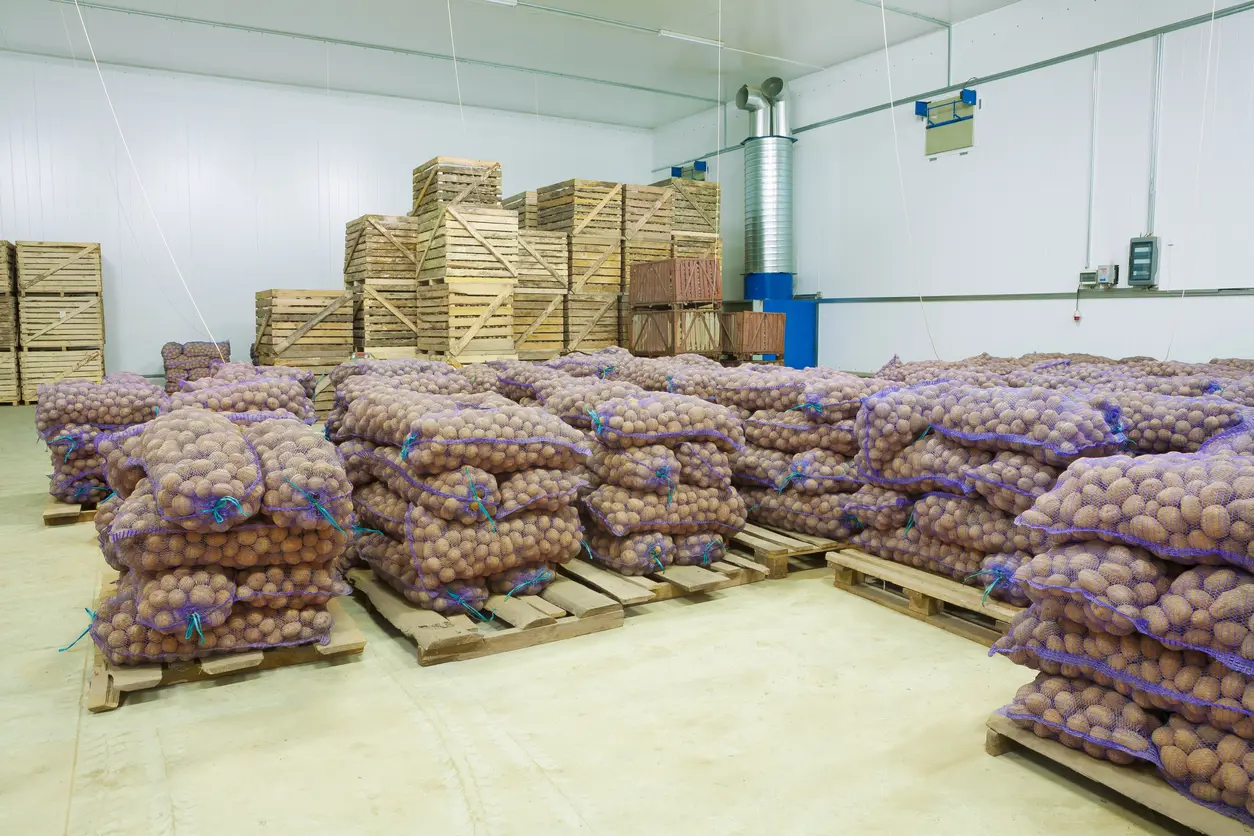
It is important to cure your potatoes to identify any damaged or diseased tubers that could compromise your entire harvest and prepare them for long-term storage. Gently brush excess soil from the potatoes. Lay the potatoes in the dark at 55 to 60 degrees Fahrenheit. The storage area should have a high relative humidity. This will help heal any minor bruising and prepare the potato skins.
After 2–3 weeks, inspect the potatoes for any signs of disease or damage, and remove any affected specimens. The rest of your potatoes can be stored. The ideal storage conditions include a temperature near 40 degrees Fahrenheit, darkness, high humidity, and good airflow. [7] Kelly A. Zarka, Donna C. Kells, David S. Douches and C. Robin Buell A Guide to Growing Potatoes In Your Home Garden Avoid storing potatoes in plastic bags or a tightly sealed container, as this can lead to rapid rotting. Stored properly, your potato harvest can keep for up to 6 months!
Alternatively, potatoes can be frozen for short-term storage, [10] Freezing Potatoes although they are best when blanched or cooked first. Potatoes can also be safely canned following recommended instructions. [11] Let's Preserve: Potatoes and Sweet Potatoes
Potatoes are the perfect crop for beginning or experienced gardeners looking to reap the benefits of their hard work for the long term. Well-adapted for growth in traditional gardens or containers, potatoes offer an opportunity to develop your gardening skills with tasty results.
Was this article helpful?
-
Potatoes in the Home Garden – 7.617; Katrina A. Zavislan, Dr. David G. Holm, and Robin Young;
https://extension.colostate.edu/topic-areas/yard-garden/potatoes-in-the-home-garden-7-617/ -
Growing potatoes in home gardens; Marissa Schuh, Extension educator, and Cindy Tong, Extension specialist;
https://extension.umn.edu/vegetables/growing-potatoes#choosing-potato-varieties-292910 -
Varietal Selection;
https://extension.usu.edu/vegetableguide/potato/varietal-selection -
Growing Potatoes in a Home Garden; University of Maryland Extension ;
https://extension.umd.edu/resource/growing-potatoes-home-garden/ -
2023 USDA Plant Hardiness Zone Map;
https://planthardiness.ars.usda.gov/ -
Planting and Spacing;
https://extension.usu.edu/vegetableguide/potato/planting-spacing -
A Guide to Growing Potatoes In Your Home Garden; Kelly A. Zarka, Donna C. Kells, David S. Douches and C. Robin Buell;
https://www.canr.msu.edu/uploads/files/growingpotatoes.pdf -
Potato fertilization on irrigated soils;
https://extension.umn.edu/crop-specific-needs/potato-fertilization-irrigated-soils -
Colorado potato beetle;
https://extension.umn.edu/yard-and-garden-insects/colorado-potato-beetle#biological-controls-3562763 -
Freezing Potatoes;
https://extension.psu.edu/freezing-potatoes -
Let's Preserve: Potatoes and Sweet Potatoes;
https://extension.psu.edu/lets-preserve-potatoes-and-sweet-potatoes




